08-17-2017, 05:36 PM
(This post was last modified: 08-17-2017, 05:57 PM by randyc.
Edit Reason: Revised Thread Title
)
http://www.metalworkingfun.com/showthrea...99&page=29
In post #283 of the above thread, I probably didn’t make very clear that using a temporary collet holder in a 4-jaw chuck was handy for operations other than just having a temporary collet system that is quick to set up. This is one of them: A .375 diameter eccentric x .250 wide needs to be turned on a one inch diameter shaft.
After first dialing the collet holder true in the chuck, it is offset by .1875 (half of the .375 eccentric), monitoring the offset with a travel indicator. A faster technique is simply to indicate the high and low spots on the diameter and adjust until the difference between them is .625. ( 1.000 O.D. - .375 eccentric diameter = .625 ) but I didn't think of it at the time.
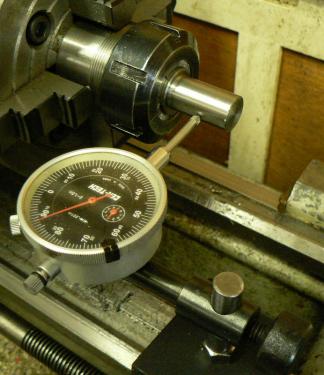
The actual operation can be done in several ways but I chose to plunge a keen ¼ HSS tool directly into the shaft because my old Sheldon lathe is pretty rigid. (This operation is equivalent to parting a one inch diameter (fairly hard) steel workpiece but with a parting tool ¼ inch wide so rigidity is absolutely mandatory !)
Obviously I want to use the tailstock center for support so after offsetting the work, I center-drilled the end. The setup had to be as sturdy as I could make it before attempting the plunge; I could imagine the nightmare if something worked loose !
The QCTP was removed because on a typical small lathe it is nowhere near rigid enough to plunge ¼ wide and 5/8 deep in semi-hard steel. Not to mention that the intermittent cut is going to try to loosen everything in the setup as it pounds on the tool.
(Carbide tooling not recommended here, both for the intermittent pounding on the cutter and because it cannot be sharpened adequately IMO.)
I replaced the QCTP with an old lantern/rocker tool post but did not attempt to use an Armstrong holder although I have many of them
The HSS cutting tool was ground first with a coarse and then with a fine grinding wheel followed by lapping and honing, at all times keeping the front (cutting) edge straight and perpendicular to the sides. I did not use any top relief (I would have if the lathe didn't have sufficient horsepower). The point is for the tip to be as strong as possible because the work is going to hammer it on every revolution l.
The cutting tool was placed directly in the lantern, packing it up to the lathe centerline as required. A slight upward tilt would probably have been helpful.
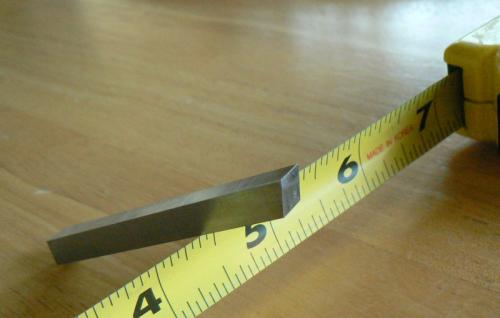
The cutting force is now (more or less) directed through the middle of the cross slide rather than being levered out in thin air as with the typical QCTP, which increases the load transmitted to the cross slide. Another reason for removing the QCTP is that like many close-to-the-headstock operations, the cutting tool must work in tight quarters like this. The lantern is ideal for this and also for working at odd angles using the Armstrong tool holders.
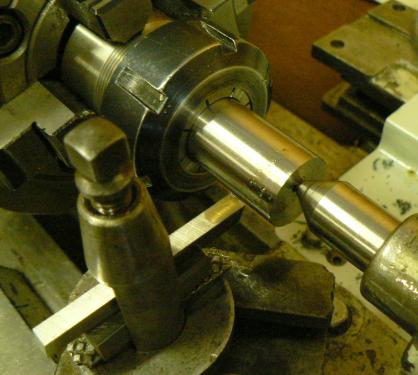
For maximum rigidity, I used a dead center. (Personally, I prefer them for any application that doesn’t require high RPM but ESPECIALLY when heavy cuts are required.) FWIW, some years ago I made an experiment to determine the relative rigidity of a dead center:
http://www.practicalmachinist.com/vb/general/lathe-dead-center-rigidity-191395/
Next, after orienting and locating the cutting tool, the carriage was locked down. The compound rest was locked and the cross slide gibs tightened enough to just allow movement with the crank.
The collet was tightened again, the tail stock was moved as close to the work as the operation allowed, a drop of way oil applied to the dead center and the dead center center was snugged against the work – moderately, not tightly – and locked.
Then I double checked everything to insure that if it could be tightened, it WAS tightened -
I started out with the lathe in back gear at the slowest speed, 50 RPM, and gently engaged the tool into the work – as the task progressed, I increased the speed to the next pulley step of 87 RPM, shortening time and obtaining a better finish.
This is what it looked like after a minute or two of plunging.

Note the chatter marks. These are almost always caused by one (or all) of three things when parting or plunging
The third item seems counter-intuitive to newbies but when parting, for example, if everything is rigid and tight, one will find that there is a “sweet spot” when feeding the cross slide that eliminates chatter, cuts faster and leaves a better finish. The sweet spot is usually a faster feed than you think but DON’T start with a fast feed. Start slow and work up !
Incidentally – also to inexperienced turners – don’t use power cross-feed for parting or plunging, you lose valuable tactile feedback when not cranking by hand. Often even experienced machinists feed manually. Manual feed allows changing DOC on the fly as the work diameter diminishes.
After I increased my feed, the finish improved although I left a few mils on the diameter for some careful file and emery paper work.
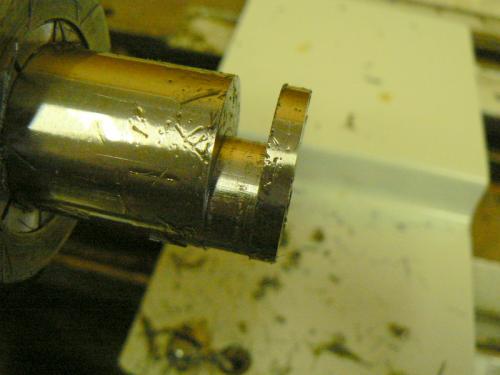
This is the finished shaft. Once the collet is offset, numerous parts can be quickly loaded and unloaded – and without the possible jaw marks from a four-jaw chuck. The possibility of the four-jaw slipping also exists due to the constant pounding, in which case the work piece would be ruined immediately.
Also, much smaller parts can be held in a collet than a four-jaw allows - smaller than 1/16 diameter as opposed to maybe 1/2 inch for a four-jaw.
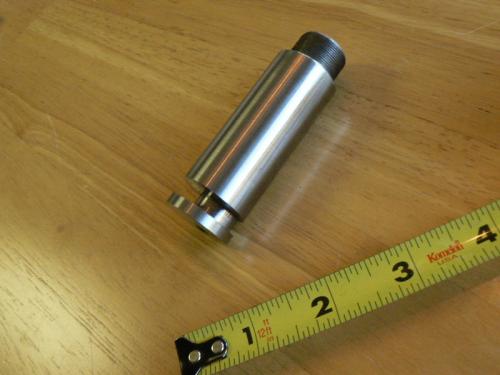
(The single-pointed threads on the end opposite the eccentric are 3/4-28 BTW.)
In post #283 of the above thread, I probably didn’t make very clear that using a temporary collet holder in a 4-jaw chuck was handy for operations other than just having a temporary collet system that is quick to set up. This is one of them: A .375 diameter eccentric x .250 wide needs to be turned on a one inch diameter shaft.
After first dialing the collet holder true in the chuck, it is offset by .1875 (half of the .375 eccentric), monitoring the offset with a travel indicator. A faster technique is simply to indicate the high and low spots on the diameter and adjust until the difference between them is .625. ( 1.000 O.D. - .375 eccentric diameter = .625 ) but I didn't think of it at the time.
The actual operation can be done in several ways but I chose to plunge a keen ¼ HSS tool directly into the shaft because my old Sheldon lathe is pretty rigid. (This operation is equivalent to parting a one inch diameter (fairly hard) steel workpiece but with a parting tool ¼ inch wide so rigidity is absolutely mandatory !)
Obviously I want to use the tailstock center for support so after offsetting the work, I center-drilled the end. The setup had to be as sturdy as I could make it before attempting the plunge; I could imagine the nightmare if something worked loose !
The QCTP was removed because on a typical small lathe it is nowhere near rigid enough to plunge ¼ wide and 5/8 deep in semi-hard steel. Not to mention that the intermittent cut is going to try to loosen everything in the setup as it pounds on the tool.
(Carbide tooling not recommended here, both for the intermittent pounding on the cutter and because it cannot be sharpened adequately IMO.)
I replaced the QCTP with an old lantern/rocker tool post but did not attempt to use an Armstrong holder although I have many of them
The HSS cutting tool was ground first with a coarse and then with a fine grinding wheel followed by lapping and honing, at all times keeping the front (cutting) edge straight and perpendicular to the sides. I did not use any top relief (I would have if the lathe didn't have sufficient horsepower). The point is for the tip to be as strong as possible because the work is going to hammer it on every revolution l.
The cutting tool was placed directly in the lantern, packing it up to the lathe centerline as required. A slight upward tilt would probably have been helpful.
The cutting force is now (more or less) directed through the middle of the cross slide rather than being levered out in thin air as with the typical QCTP, which increases the load transmitted to the cross slide. Another reason for removing the QCTP is that like many close-to-the-headstock operations, the cutting tool must work in tight quarters like this. The lantern is ideal for this and also for working at odd angles using the Armstrong tool holders.
For maximum rigidity, I used a dead center. (Personally, I prefer them for any application that doesn’t require high RPM but ESPECIALLY when heavy cuts are required.) FWIW, some years ago I made an experiment to determine the relative rigidity of a dead center:
http://www.practicalmachinist.com/vb/general/lathe-dead-center-rigidity-191395/
Next, after orienting and locating the cutting tool, the carriage was locked down. The compound rest was locked and the cross slide gibs tightened enough to just allow movement with the crank.
The collet was tightened again, the tail stock was moved as close to the work as the operation allowed, a drop of way oil applied to the dead center and the dead center center was snugged against the work – moderately, not tightly – and locked.
Then I double checked everything to insure that if it could be tightened, it WAS tightened -
I started out with the lathe in back gear at the slowest speed, 50 RPM, and gently engaged the tool into the work – as the task progressed, I increased the speed to the next pulley step of 87 RPM, shortening time and obtaining a better finish.
This is what it looked like after a minute or two of plunging.
Note the chatter marks. These are almost always caused by one (or all) of three things when parting or plunging
- Lathe is just not rigid enough
- Setup is not tight enough
- Feed is too slow
The third item seems counter-intuitive to newbies but when parting, for example, if everything is rigid and tight, one will find that there is a “sweet spot” when feeding the cross slide that eliminates chatter, cuts faster and leaves a better finish. The sweet spot is usually a faster feed than you think but DON’T start with a fast feed. Start slow and work up !
Incidentally – also to inexperienced turners – don’t use power cross-feed for parting or plunging, you lose valuable tactile feedback when not cranking by hand. Often even experienced machinists feed manually. Manual feed allows changing DOC on the fly as the work diameter diminishes.
After I increased my feed, the finish improved although I left a few mils on the diameter for some careful file and emery paper work.
This is the finished shaft. Once the collet is offset, numerous parts can be quickly loaded and unloaded – and without the possible jaw marks from a four-jaw chuck. The possibility of the four-jaw slipping also exists due to the constant pounding, in which case the work piece would be ruined immediately.
Also, much smaller parts can be held in a collet than a four-jaw allows - smaller than 1/16 diameter as opposed to maybe 1/2 inch for a four-jaw.
(The single-pointed threads on the end opposite the eccentric are 3/4-28 BTW.)






![[Image: TomsTechLogo-Profile.png]](http://tomstechniques.com/wp-content/uploads/2013/11/TomsTechLogo-Profile.png)
